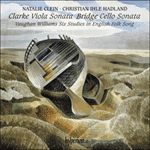
Welcome to Hyperion Records, an independent British classical label devoted to presenting high-quality recordings of music of all styles and from all periods from the twelfth century to the twenty-first.
Hyperion offers both CDs, and downloads in a number of formats. The site is also available in several languages.
Please use the dropdown buttons to set your preferred options, or use the checkbox to accept the defaults.

| Natalie Clein (cello), Christian Ihle Hadland (piano)» More |
Overnight Clarke became a cause célèbre, both in England and America. Several performances of the work were given and it was published by Chester in 1921. Elizabeth Sprague Coolidge was so impressed by the Viola Sonata that she commissioned a Rhapsody for cello and piano from Clarke which was performed in 1923 at the Berkshire (Massachusetts) Festival by May Mukle and Myra Hess.
The Viola Sonata is in three movements and is headed by a quotation from Alfred de Musset’s poem La Nuit de Mai:
Poète, prends ton luth; le vin de la jeunesse
Fermente cette nuit dans les veines de Dieu.
The first and third movements are big-boned pieces with a clear thematic link between them, and the second is a brilliant but delicate scherzo in compound time. The language has that ambiguous quality mentioned earlier, where Debussy and Ravel (particularly of the Piano Trio) mix with the Englishness represented by modality and the flexibility of melody inspired by folksong. It is very much of its period, and the fantasy-like character of the outer movements places it firmly in the style of music favoured by English composers of the time, especially as encouraged by the Cobbett Competitions. (These stipulated the composition of a single-movement piece with a variety of moods suggestive of larger forms in the spirit of the ‘fantasy’ which was common in England in the sixteenth and seventeenth centuries.)
In 1939 Rebecca Clarke visited America, and was there when war was declared. She was denied a return visa and thus forced to stay in the USA. She worked as a nanny to a family in Connecticut for a while, but visiting New York in 1944 she met James Friskin with whom she had been a student at the Royal College of Music and who was now teaching at the Juilliard School. They were both unmarried and in their late fifties and decided to marry, which put the seal on Clarke’s decision as to whether or not to return to England. She remained in New York until her death in 1979.
from notes by Paul Spicer © 1994
Cette œuvre très personnelle de Clarke est aujourd’hui considérée à juste titre (à mon avis) comme l’une des créations majeures de la musique instrumentale anglaise du début du XXe siècle. Lorsqu’elle la présenta dans un concours organisé en 1919 par Elizabeth Sprague Coolidge, la mécène américaine commanditaire de tellement d’œuvres de musique de chambre importantes de la première moitié du siècle dernier, cette sonate reçut un deuxième prix grâce à un vote prépondérant de Mme Coolidge elle-même. La suite pour alto et piano d’Ernest Bloch remporta le premier prix. Les musiciens et les critiques votant pour les œuvres à la suite de leur exécution furent très surpris lorsque l’identité et surtout le sexe du deuxième prix furent révélés.
extrait des notes rédigées par Paul Hindmarsh © 2019
Français: Marie-Stella Pâris
Dieses zutiefst persönliche Werk Clarkes wird heute—nach Ansicht des Verfassers zu Recht—zu den bedeutendsten englischen Kammermusikschöpfungen des frühen 20. Jahrhunderts gezählt. 1919 lobte die Amerikanerin Elizabeth Sprague Coolidge, die so viele bedeutende Kammermusikwerke in der ersten Hälfte des 20. Jahrhunderts förderte, einen Wettbewerb aus, zu dem Clarke das Werk einreichte; mit der entscheidenden Stimme von Mrs. Coolidge bekam es den 2. Preis zugesprochen. Der 1. Preis war an die Suite für Bratsche und Klavier von Ernest Bloch gegangen. Bei Musikern und Kritikern, die nach der Aufführung über die Werke abstimmten, herrschte große Überraschung, als die Identität und vor allem das Geschlecht der zweitplatzierten Komponistin offenbart wurden.
aus dem Begleittext von Paul Hindmarsh © 2019
Deutsch: Friedrich Sprondel
 Clarke (R): Viola Sonata; Bridge: Cello Sonata Clarke (R): Viola Sonata; Bridge: Cello SonataA perfectly planned recital of English music from one of this country’s leading cellists.» More |

